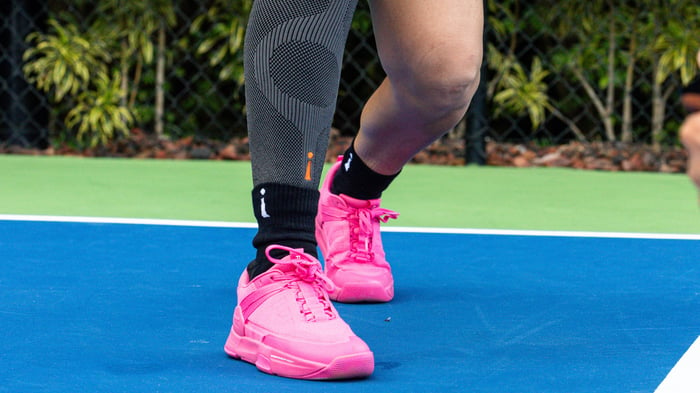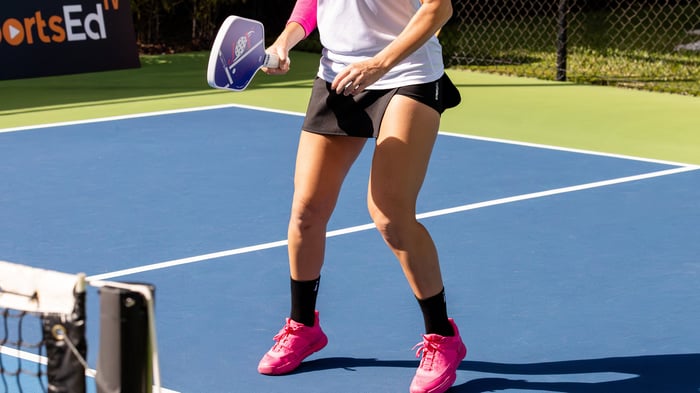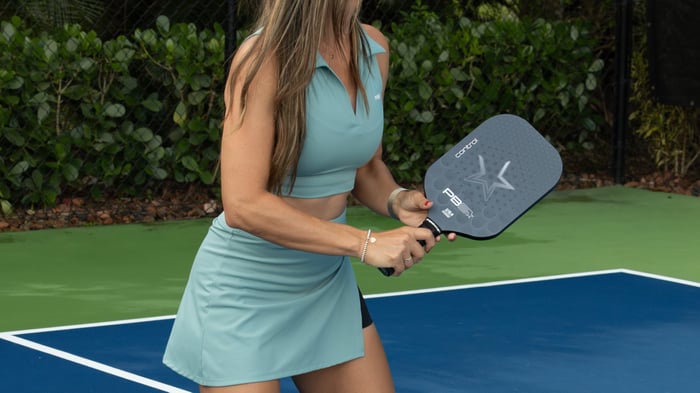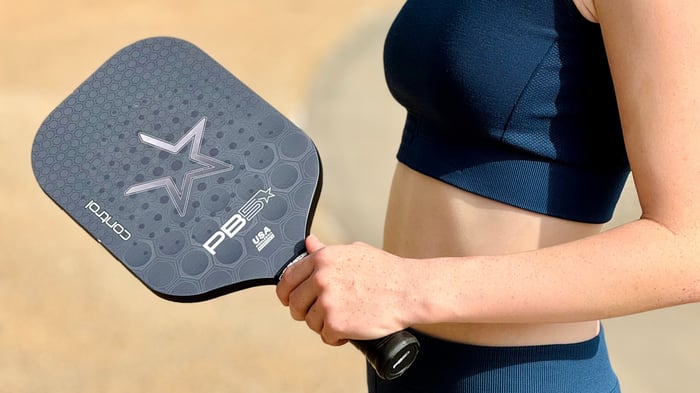Key takeaways:
Pickleball vs. ping pong may share paddle sport roots, but they differ dramatically in court size, equipment, and gameplay style.
Both sports demand quick reflexes and sharp hand-eye coordination, making them fast-paced and fun for all ages.
Understanding the unique rules and gear for each game helps you choose the paddle sport that fits your style and fitness goals.
Ever wondered if pickleball is like ping pong? While these paddle sports might look similar at first glance, they're as different as apples and oranges—or should we say pickles and ping pong balls? For starters, pickleball courts are about three times larger than ping pong tables. That's right, you'll be covering a lot more ground on the pickleball court!
Both sports share some cool traits, though. They'll have you moving fast, thinking on your feet, and showing off your awesome hand—eye coordination. But here's the real kicker: pickleball and ping pong aren't just about the game—they're about the people you meet and the fun you have.
At PB5star, we're all about that community vibe. That's why we pour our hearts into creating top-notch pickleball gear that helps you play your best and look great doing it. Curious about how pickleball might up your paddle game?
Overview of pickleball and ping pong
Before diving into similarities and differences, it’s helpful to understand what sets each sport apart at a glance. Both pickleball and ping pong are fast-paced, fun paddle sports, but their setups, equipment, and play styles make for two very different experiences.
Pickleball:
A paddle sport combining elements of tennis, badminton, and table tennis. Played on a court, either indoors or outdoors.
Uses a solid paddle (larger than a ping pong paddle) and a plastic ball with holes (like a wiffle ball).
One of the fastest-growing sports in America, popular for its social and accessible play.
Ping pong (Table tennis):
A fast-paced sport played with small paddles and a lightweight ball on a table divided by a net.
Uses a small wooden paddle covered with rubber and a small plastic ball.
An Olympic sport with global popularity and a reputation for lightning-fast reflexes.
How each game is played
Understanding the distinct play styles of pickleball and ping pong provides insight into what makes each sport engaging and unique.
Pickleball gameplay
Serve and Start: The game starts with an underhand serve, which must be hit diagonally across the net, similar to tennis but without bounce.
Court Play: Played on a 44 x 20 ft court, players use paddles to volley the ball over a 36-inch net. The plastic ball with holes introduces a slower pace, encouraging longer rallies and strategic positioning.
Scoring: Points are scored only by the serving team, and games typically go to 11 points, requiring a 2-point advantage to win.
Player Dynamics: As a doubles game primarily, teamwork and court communication are vital, demanding players shift fluidly to optimize coverage.
Ping pong (Table tennis) gameplay
Serve and Start: Games begin with a serve that must first bounce on the server's side, then over the net to the opponent's side.
Table Play: Played on a 9 x 5 ft table with a net height of 6 inches, ping pong is characterized by its rapid-fire exchanges using small, rubber-covered paddles.
Scoring: Points can be scored by either player on any serve, with matches also going to 11 points, needing a 2-point lead to clinch victory.
Game Speed and Spin: The fast-paced nature and ability to apply spin to the lightweight ball creates dynamic play, where quick reflexes are rewarded.
Key similarities
Ever wondered how pickleball and ping pong are similar? These paddle sports share several key features that make them both exciting and accessible. Both games have you swinging paddles to hit a ball over a net, aiming to outsmart your opponent. Quick reflexes, spot-on hand-eye coordination, and a dash of strategy, these skills are your ticket to success in both pickleball and ping pong.
One of the coolest things about pickleball vs. table tennis is how both are versatile. Whether you're looking for a chill game with friends or itching for some serious competition, both sports have you covered.
This flexibility is part of why pickleball has seen such a boom, with participation skyrocketing by 158.6% in just three years. So whether you're a seasoned athlete or just starting out, there's a place for you in both pickleball and ping pong. Ready to give pickleball a try? Check out our guide to pickleball basics to get started!
Let's talk gear. While both sports use paddles, there's a size difference that affects how you play. Ping pong paddles are compact, about 10 inches long, perfect for those lightning-fast table exchanges. Pickleball paddles, on the other hand, can be up to 24 inches in combined length and width. Why the size up? It's all about covering more court space and packing a bit more power into your shots. Despite these differences, players of both sports will tell you that mastering your paddle is key to upping your game.
Both pickleball and ping pong involve hitting a ball over a net using paddles, but there are unique details to each. Pickleball uses a plastic ball with holes (like a wiffle ball) on a larger court, while ping pong uses a small, lightweight sphere on a table. The rules, serving styles, and points system differ, giving each game its own style and pace.
Major differences
If you’ve ever debated the difference between pickleball and ping pong, there are a few things to know. Pickleball and ping pong, while both paddle sports, offer distinct experiences that shape their vibrant communities. Let's explore the key differences that make each sport unique.
Court size: Pickleball courts span 44 feet long by 20 feet wide, dwarfing ping pong tables at just 9 feet by 5 feet. This vast difference between pickleball and ping pong creates a more dynamic playing environment for pickleball, demanding greater movement and strategy from players.
Equipment: Pickleball enthusiasts wield larger paddles made of composite materials like graphite or carbon fiber, allowing for powerful shots and precise control. Ping pong players, on the other hand, use smaller, wood-based paddles with rubber surfaces designed for lightning-fast, spin-heavy exchanges. Explore PB5star's paddle collection to find your perfect match for pickleball.
Ball type: Pickleball uses a plastic ball with holes, akin to a wiffle ball, while ping pong employs a small, lightweight plastic sphere. The pickleball's design facilitates slower gameplay and extended rallies, fostering a social atmosphere on the court.
Net height: Pickleball nets stand at 36 inches on the sidelines, dipping to 34 inches in the center. Ping pong nets maintain a consistent 6-inch height. These differences significantly impact shot selection and gameplay strategies in each sport.
Scoring system: Pickleball games typically go to 11 points (win by 2), with only the serving team able to score. This creates a strategic element where serving becomes crucial. Ping pong matches also go to 11 points, but either side can score on any rally, leading to faster-paced games and different tactical approaches.
Playing surface: Pickleball courts adapt to various indoor and outdoor surfaces, similar to tennis, allowing for diverse playing experiences. Ping pong remains an indoor sport, exclusively played on specially designed tables.
These unique aspects of each sport create distinct experiences for players, contributing to the passionate communities that surround both pickleball and ping pong.
Pickleball vs. ping pong: A side-by-side comparison
If the key differences have you confused, don’t worry—we’ve got you covered. Here’s a side-by-side comparison to help clarify things. This detailed comparison of pickleball and ping pong will highlight the unique aspects of each game, helping you appreciate their distinct characteristics.
Aspect | Pickleball | Ping Pong |
Equipment | Larger paddles (up to 24 inches combined length and width), made of composite materials like graphite or carbon fiber. Provides power and control for outdoor play. | Smaller paddles (about 10 inches long), wood-based with rubber surfaces. Designed for fast, spin-heavy exchanges. |
Court Dimensions | 44 feet long by 20 feet wide. Larger court promotes more movement and strategy. | 9 feet long by 5 feet wide. Compact size enables quick reactions and precise shots. |
Net Height | 36 inches at posts, 34 inches in center. Encourages a mix of volleys and groundstrokes. | 6 inches consistently. Allows for rapid back-and-forth play across the table. |
Ball Type | Plastic ball with holes (similar to a wiffle ball). Designed for outdoor use and slower-paced rallies. | Small, lightweight plastic sphere. Enables high-speed play and extreme spin. |
Scoring System | Games to 11 points (win by 2), only the serving team scores. Adds strategic importance to serving. | Games to 11 points, either side can score on any rally. Results in faster-paced games. |
Playing Surface | Adaptable to various indoor and outdoor surfaces including asphalt, concrete, and specialized court materials. | Indoor-only on specially designed tables. Consistent playing surface for standardized play. |
While ping pong offers lightning-fast, close-quarters gameplay, pickleball provides a more dynamic experience with its larger court and versatile equipment. The differences in equipment, court size, and rules create distinct strategies and skills for each sport.
Pickleball’s adaptability to various surfaces and its blend of tennis, badminton, and table tennis elements contribute to its growing popularity. Whether you’re drawn to the quick reflexes required in ping pong or the strategic court coverage of pickleball, both sports offer exciting ways to stay active and connect with a vibrant community.
Enhance your performance with PB5star gear
So, is pickleball like ping pong? As you've seen, pickleball offers a unique blend of fun and challenge, whether you're transitioning from ping pong or just starting out. To truly excel on the court, having the right gear is crucial.
With the pickleball equipment market projected to reach $155.4 billion by 2033, players clearly recognize the value of quality equipment. PB5star leads the way in this growing market, offering a range of performance-driven gear designed to elevate your pickleball experience. Our Control paddle optimizes precision shots, while our core performance shirts keep you cool under pressure. Plus, our upcoming footwear line promises to deliver the perfect blend of support and agility for those intense rallies.
Don't miss out on the chance to refine your pickleball skills with PB5star's high-quality pickleball gear and apparel. Our products are crafted with care to ensure durability and satisfaction, backed by our Match-Fit promise.
Join the growing community of nearly 50 million adult American pickleball enthusiasts who trust PB5star to look good, feel great, and play their best. Act now to secure your limited-edition items and be among the first to experience our new footwear line when it launches. Elevate your game with PB5star, where style meets performance on and off the court.
FAQs
Is pickleball like ping pong?
There are some similarities, but is pickleball like ping pong? Not really. Pickleball takes place on a larger court, like a mini tennis setup, giving you room to move and strategize with a wiffle-like ball. Ping pong, on the other hand, is all about quick reflexes and tight table tennis action, using a smooth ball that zooms across a small table for high-speed rallies.
What are the main differences in equipment between the pickleball and ping pong?
Pickleball uses larger composite paddles and a ball with holes, enhancing control and power over a larger court. Ping pong features compact paddles and a smooth ball for high-speed, spin-focused table play.
How does the pace of play differ in pickleball versus ping pong?
Pickleball's use of a larger court and wiffle-like ball tends to slow down play, encouraging strategic rallies. Ping pong’s fast pace comes from its smaller size and focus on quick, spin-intensive exchanges.
Can skills from ping pong be applied to pickleball?
Absolutely! Both sports require sharp hand-eye coordination and quick reflexes. Transitioning from ping pong to pickleball involves adapting these skills to a larger playing area and slightly different strategic nuances.
Why do people compare pickleball to ping pong?
People often group pickleball and ping pong together because both are paddle sports that test your quickness and strategy. They’re accessible and packed with adrenaline, drawing you into their pump-up play whether you’re just having fun or seeking fierce competition.







